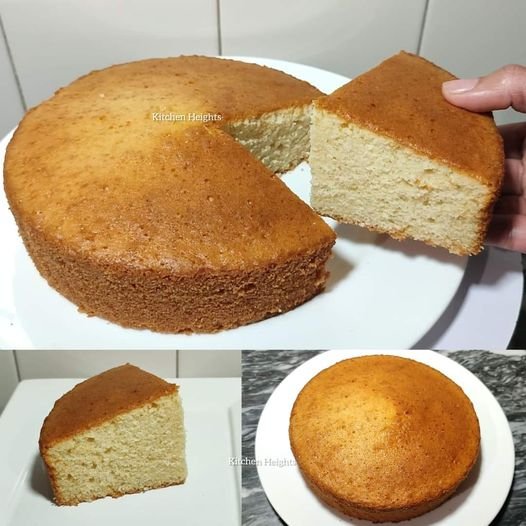Here’s a detailed recipe for making a Sponge Cake without an Oven and without Butter. This method uses a stovetop, yielding a soft, fluffy cake that’s just as delicious as one made in an oven.
Ingredients:
- 1 cup all-purpose flour (125g)
- 3 large eggs (room temperature)
- ¾ cup granulated sugar (150g)
- 1 tsp vanilla extract
- 1 tsp baking powder
- ¼ tsp salt
- ¼ cup milk (60ml)
- 2 tbsp vegetable oil (or any neutral oil)
- 1 tsp lemon juice or white vinegar (optional, for extra fluffiness)
Equipment:
- Large mixing bowls
- Whisk or hand mixer
- 7-inch round cake pan or any pan that fits into your stovetop setup
- A large deep pan or pot with a lid (for stovetop baking)
- Trivet or metal stand for inside the pan
- Parchment paper (optional, for lining the pan)
Instructions:
1. Prepare Your Cooking Setup
Before starting on the cake batter, get your stovetop setup ready. You will need a large, deep pan with a lid. This pan will act as a makeshift oven. You’ll also need a trivet or any metal stand to place inside the pan so that the cake pan is elevated and doesn’t touch the bottom directly.
Place the pan on the stove and preheat it on medium heat for about 10 minutes.
2. Prepare the Cake Pan
Grease your cake pan with oil or cooking spray. For extra precaution, you can line the bottom of the pan with parchment paper to prevent sticking. Set the pan aside.
3. Sift the Dry Ingredients
In a medium bowl, sift together the flour, baking powder, and salt. This ensures there are no lumps and helps the cake rise evenly. Set this bowl aside for now.
4. Beat the Eggs and Sugar
In a large mixing bowl, crack in the eggs. Add the sugar and use a whisk or hand mixer to beat the mixture for about 5-7 minutes. You want to beat the eggs until they become pale, thick, and tripled in volume. This is crucial for achieving a light, fluffy sponge cake.
The eggs should have a ribbon-like consistency, meaning when you lift the whisk, the batter should fall in thick ribbons that hold their shape for a few seconds before blending back into the mixture.
5. Add Vanilla and Lemon Juice
Once your eggs are light and airy, add the vanilla extract and lemon juice (or vinegar). The lemon juice or vinegar helps stabilize the egg mixture and gives the cake a fluffier texture.
6. Incorporate the Dry Ingredients
Gently sift the dry ingredients (flour mixture) into the egg mixture in three batches. After each addition, gently fold the flour into the eggs using a spatula. Be careful not to overmix or deflate the eggs. The key to a light sponge cake is maintaining as much air in the batter as possible.
7. Add Milk and Oil
In a small saucepan, heat the milk and oil together until warm but not boiling. This step ensures the oil and milk incorporate smoothly into the batter without causing it to deflate.
Slowly pour the warm milk-oil mixture into the batter and gently fold it in until the mixture is smooth and well combined. Again, be gentle to avoid deflating the batter.
8. Pour the Batter into the Pan
Once your batter is smooth and fluffy, pour it into the prepared cake pan. Give the pan a light tap on the countertop to release any air bubbles.
9. Cook the Cake on the Stovetop
Place the cake pan on the trivet inside the preheated large pan. Cover the large pan with its lid. It’s important that the lid fits tightly to trap heat and mimic the effect of an oven.
Cook the cake on low heat for about 30-35 minutes. Avoid opening the lid during the first 20 minutes, as this can cause the cake to deflate.
After about 30 minutes, you can check for doneness by inserting a toothpick into the center of the cake. If it comes out clean or with a few moist crumbs, the cake is done. If it still has wet batter on it, cover the pan again and cook for another 5-10 minutes, checking periodically.
10. Cool the Cake
Once the cake is cooked through, carefully remove the cake pan from the large pan and set it aside to cool for about 10-15 minutes. Once the cake has cooled slightly, run a knife around the edges of the pan to loosen it and turn the cake out onto a wire rack to cool completely.
11. Optional: Decorate
You can serve the sponge cake plain, or if desired, dust it with powdered sugar or frost it with whipped cream or your favorite icing. It also pairs beautifully with fresh fruits like strawberries, raspberries, or mangoes.
Tips for Perfect Sponge Cake:
- Beat the eggs properly: The volume in the eggs is what gives the cake its height and lightness. Make sure to beat the eggs until they are thick and fluffy.
- Fold gently: When adding flour and other ingredients to the egg mixture, fold gently to avoid losing air. Overmixing can make the cake dense.
- Use low heat on the stovetop: A low flame is crucial to ensure the cake cooks evenly without burning the bottom.
- Experiment with flavors: You can add citrus zest, almond extract, or cocoa powder to the batter for a twist.
Conclusion:
This sponge cake recipe is simple, requires no oven, and is butter-free. The result is a soft, airy cake with a delicate crumb, perfect for a quick dessert or a light snack. By cooking the cake on the stovetop, you get a moist texture and a golden exterior without the need for any fancy equipment.
